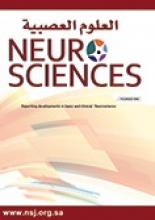Abstract
OBJECTIVE: Early myoclonic encephalopathy (EME) is a rare epileptic syndrome characterized by neonatal onset of severe recurrent seizures of multiple types often resistant to antiepileptic drugs (AEDs). Topiramate (TPM) is a new AED, which has a wide spectrum of antiepileptic activities suggesting a potentially valuable therapeutic profile. There is limited clinical data available on TPM use in infants and our aim is to report our experience with TPM for the treatment of infants with intractable seizures secondary to EME.
METHODS: Prospective, open label, add on trial of TPM in treating a series of infants with EME at King Faisal Specialist Hospital and Research Centre and King Abdul-Aziz University Hospital, Jeddah, Kingdom of Saudi Arabia between June 1999 and March 2002. Topiramate was started at 12.5 mg/day and was increased by doubling the dose every week until the minimum effective dose was reached (seizure free outcome) or up to a maximum of 10 mg/kg/day.
RESULTS: Four consecutive infants (2 males and 2 females) were included. In addition to daily seizures, they all had global hypotonia, developmental delay, and progressive microcephaly. The syndrome was cryptogenic in 3, and one had nonketotic hyperglycinemia. Initial electroencephalograms showed generalized epileptic burst suppression pattern. Infants were tried on multiple AEDs (6-11, mean 7.5) with no success. Topiramate was added at age 5-12 months (mean 9) reaching a maximum dose of 5.5-10 mg/kg/day (mean 7.6). The infants were then followed for up to 19 months (mean 13.5). After introducing TPM, one infant became completely seizure free and 3 had significant (>50%) seizure reduction. Electroencephalograms in 3 infants showed marked improvement. One infant had weight loss that resulted in discontinuing the drug after 6 months. Follow-up renal ultrasound findings were normal in all infants.
CONCLUSION: Topiramate is effective and safe in treating infants with intractable epilepsy secondary to EME.
- Copyright: © Neurosciences
Neurosciences is an Open Access journal and articles published are distributed under the terms of the Creative Commons Attribution-NonCommercial License (CC BY-NC). Readers may copy, distribute, and display the work for non-commercial purposes with the proper citation of the original work.






